STEP 4. Day 2. How to make spawn jars and spawn bags
On the previous step you've already cooked the substrate for magic mushrooms. Now you need to prepare spawn jars or spawn bags in order to proceed with sterilisation process.
For this purpose growers use different kind of jars, containers or spawn bags for substrate with inoculation port and breathable air filter.
Let's figure out different options!
What is inoculation port and air filter?
Each container, either a polypropylene heat-resistant bag or any jar with lid should be equipped with an inoculation port and a breathable air filter.
Inoculation port (aka injection port) — is an entry point for a syringe needle containing the liquid spore solution or liquid culture to inoculate the sterile substrate. It must be protected agains any competing microorganisms contamination through it. Bactericidal breathable patch, butyl rubber self-healing injection ports (aka bottle stoppers) or heat-resistant RTV-silicone sealant is used for this purpose.
Breathable air filter — is a filter that provides gas exchange during the colonisation period. It must be protected by bactericidal layer to prevent any competing microorganisms from entering through it. Bactericidal breathing patch, Luer lock syringe filters, and synthetic filter disks are used for this purpose.
Mushroom cultivators practice in different ways. Someone makes two holes in the lid: one for injection port and one for filter. Someone makes several ports for inoculation and several filters for air exchange.
It is cheap and easy to make by your own or you can buy ready to use jars with lid components for mushroom spawn.
Jars, lids and lid components for Spawn Jars
There is a huge variety of materials that can make growing process easier. Let's take a look at the different options and alternatives.
❇️ Mason jars for spawn
Glass Mason jars with metal lids. Each lid consist of two parts: a replaceable lid disc with a rubber seal around the rim and threaded ring
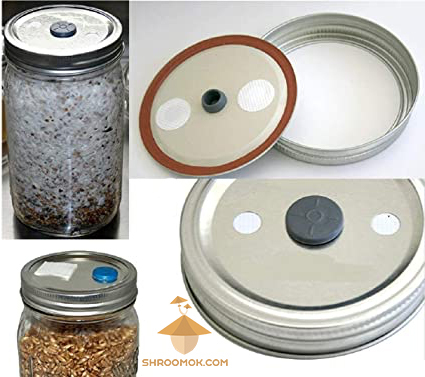
Glass Mason jars with heat-resistant autoclavable plastic lids. You can prepare your own or buy ready-made lids. Inoculation port — butyl rubber injection port. Filter — laboratory funnel filter or substitute with a patch.
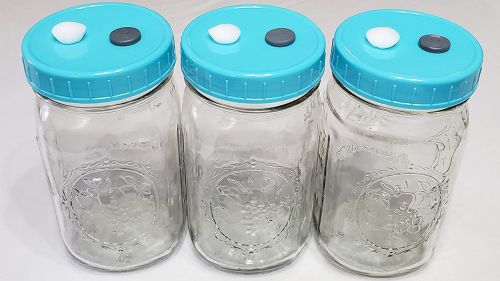
🔴 In fact you can use any glass jars for canning
Shroomok's Choice on Amazon:
Ball Wide Mouth Mason Jars with Lids & Bands | 16-oz | 2-Pack $12.00
Ball Wide Mouth Mason Jars with Lids & Bands | 24 oz | 2-Pack $10.00
Ball Wide Mouth Mason Jars with Lids & Bands | 16-oz | 6-Pack $22.99
Ball Wide Mouth Mason Jars with Lids & Bands | 32 oz | 12-Pack $29.13
❇️ Lid components for spawn jars
Each lid should be equipped with inoculation port (butyl rubber injection port) and a air filter (synthetic patch or micropore nylon lab filter).
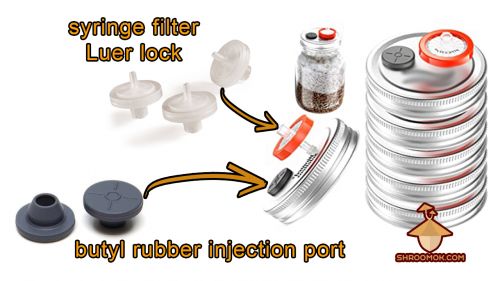
Butyl rubber self-healing bottle stoppers is a great option for inoculation port.
Luer-lock syringe filter is a great option for air filter.
These components can be installed in any kind of lids (polypropylene or metal), polypropylene containers or spawn bags. All components are autoclavable and reusable!
❗️Use heat resistant RTV silicone to instal, glue and seal lid components!
Shroomok Choice on Amazon
Plastic (5PP) or Stainless steel autoclavable lids:
Plastic Mason Jar Lids, Wide & Regular, 24 Pack $15.99
Stainless Steel Mason Jar Lids and Rings, Wide & Regular, 48 Pack - $15.99
Air filters for lids:
Synthetic Filter Disc for Air filter - 64/128/256 pcs. - $7.99
Syringe Filters PTFE Hydrophobic - 25 pcs. - $14.49
Inoculation port for lids:
Mushrooms Self Healing Injection Ports - 20mm, 100 pcs. - $9.99
2-in-1: Synthetic Filter Paper Stickers 64 pcs & 100 pcs Injection Ports - $9.99
To glue and seal lid components:
High Temperature RTV Silicone and Sealant - Red - 3 oz. - $5.99
Ready to use Jars with Lids + air filter + inoculation port:
Wide Mouth Mason Jar Plastic Lid + Syringe Filter + Self Healing Injection Ports - 3 pcs - $13.99
3-in-1: Ready to use Mason Jar Lid, Syringe Filter & Self Healing Injection Ports - 6 pcs - $22.99
❇️ Heat-resistant polypropylene spawn bags
You can make by your own or use ready-made bags with inoculation port and air filter.
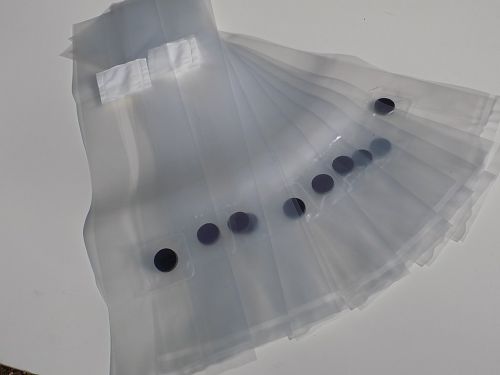
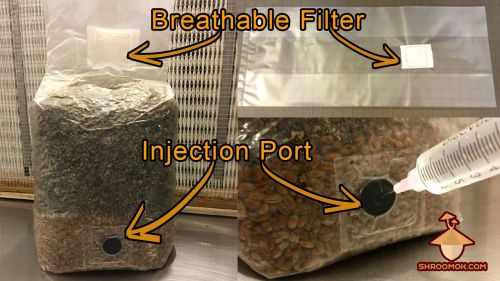
Shroomok's Choice on Amazon:
Middle Mushroom Spawn Bags with Filter -10/20/50/100 pcs. - $9.99
Large Mushroom Grow Bags with Gas Filter - 10/25/100 pcs. - $11.89
3-in-1: Autoclavable Grow Bag + Injection Port + CO2 Filter - 10 pcs - $28.49
❇️ Glass canning jars for Spawn Jars
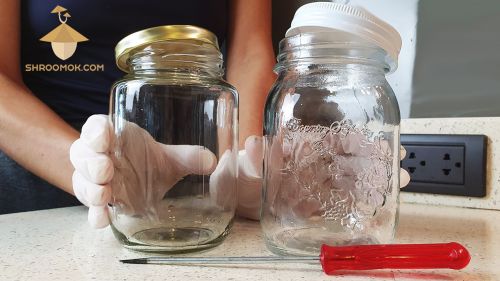
❇️ Heat-resistant polypropylene autoclavable jars for Spawn Jars
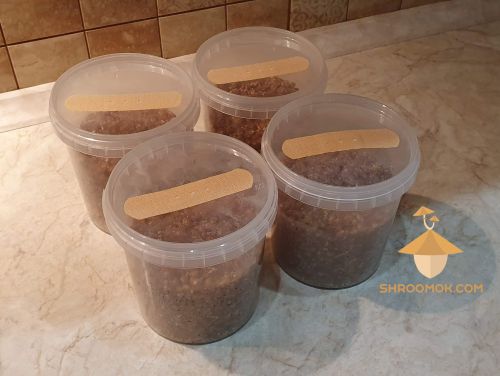
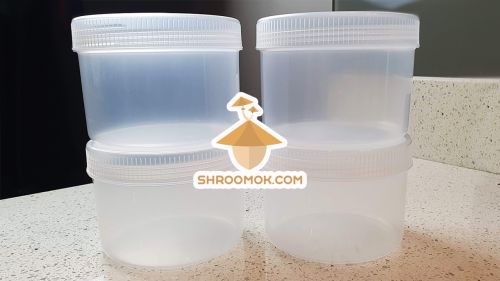
How to identify heat-resistant autoclavable plastic for spawn jar?
Look for 5PP and "for food" labels
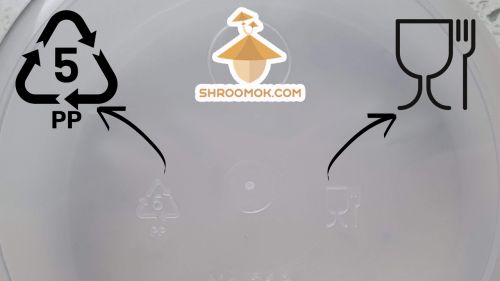
Shroomok's Choice on Amazon:
Polypropylene Jars for Grain Spawn & LC - 24 oz. (16 oz, 32 oz available) - 9 Sets - $11.97
Polypropylene Jars with Lid for Grain Spawn or LC - 12/24/50-Pack 8/16/32 oz. - $15.99
Autoclavable Reusable Polypropylene Jars with CO2 Filter in the Lid |17-oz | - 6 pcs - $22.99
How to make injection port with RTV silicone
You can use heat-resistant red RTV silicone for DIY self-healing injection port. This is a cheap alternative to butyl rubber bottle stoppers
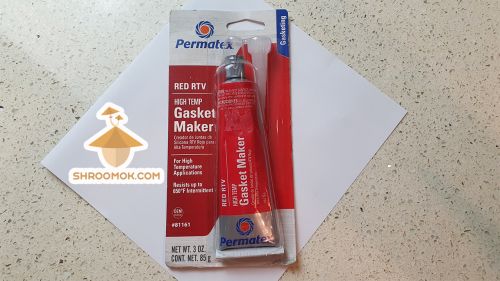
Shroomok's Choice on Amazon:
High Temperature RTV Silicone Gasket Maker and Sealant - Red - 3 oz. - $5.99
Fill the hole for the inoculation port with heat-resistant silicone sealant (rtv silicone) on the both sides.
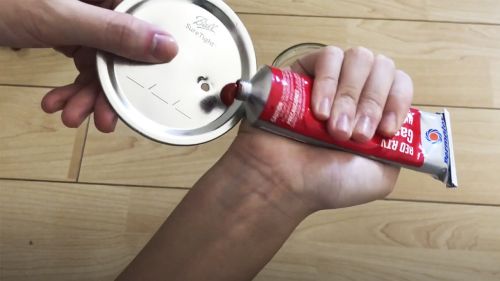
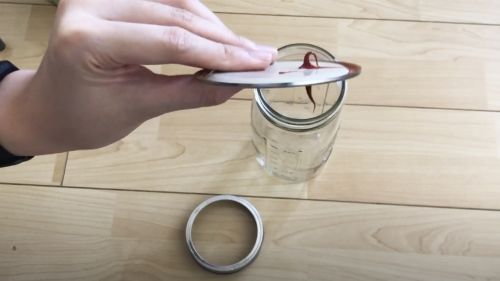
The silicone that hasn't yet solidified should be pressed lightly with a napkin inside and outside of the lid. So that it takes the shape of a tablet or wax seal. Wait for the sealant to completely solidify.
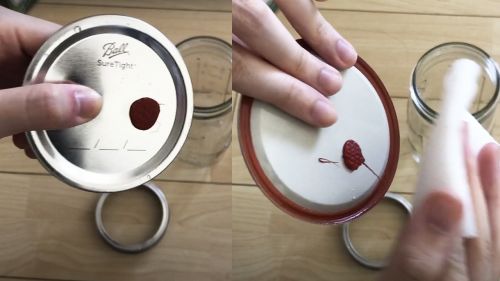
Don't forget to make another separate hole in such lids for air filter and cover it with patch or filter disc.
Synthetic Filter Disc for Air filter - 64/128/256 pcs. - $7.99
One more option as example. Spawn jar with modified lid, where inoculation port - rtv silicone, air filter - polyfill. It works, however less reliable IMAO
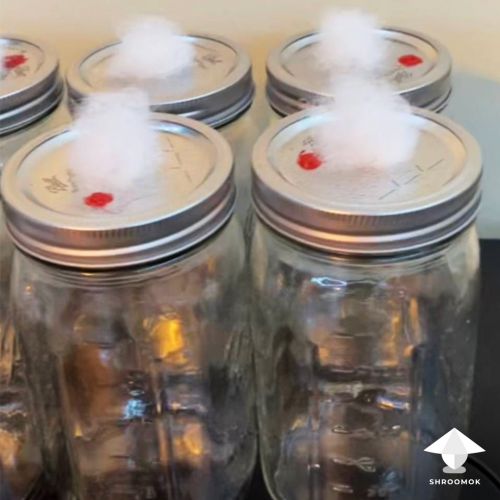
Polyester Fiber, 200g $9.49
What to use is up to you!
DIY spawn jars
To make DIY jars and lids for substrate you need:
- Jars with lids (volume, types of jars and lids we are going to discuss below).
- Screwdriver/nail/awl/drill with a diameter of 5-10 mm.
- Bactericidal breathing patch — 1-2 per lid.
- Heat-resistant rtv silicone sealant — optional.
What volume for spawn jars is needed
Any jar that fits your pressure cooker (autoclave or multicooker) from 250 ml to 1 liter. We use 500 ml and 700 ml jars. For us these are the optimal volumes. The shape of the jars does not matter.
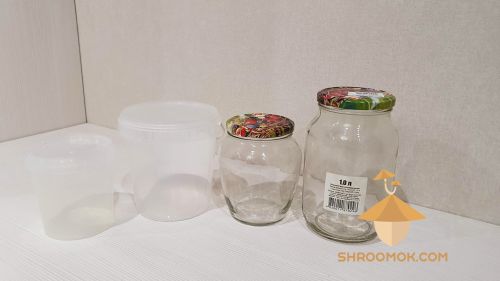
🔴 Note: The shape of the jars is important for PF-tek growing. Use cylindrical or conic jars without narrow neck (neck should be wider than the bottom), so that you can take out the mushroom cake safe and sound or you can open it up with some extreme demonstarted in the video here: How to remove mushroom cake from glass jar with narrow neck?
Jars more than 1 liter or 1 Quart are not recommended. Why?
- First, the jar may not fit in the pressure cooker (multicooker).
- Secondly, a large volume will require more time to colonize the substrate. Accordingly, more risk for souring and contamination, which can take over the substrate faster than the mycelium of psilocybin mushrooms.
- Third, it is better to share the risks and make more jars of smaller volume. So that, increase the chances of future mushroom survival.
- With more jars you can experiment and try different teks
What kind of jars are needed
We use glass screw jars with metal twist-off lids (withstand temperature over +160°C or 320°F) or Mason jars.

And heat-resistant polypropylene jars with polypropylene lids (withstand temperature up to +140°C or 284°F).

Pros of glass jars:
- Availability.
- Easily withstand higher temperatures than polypropylene jars. This point is especially important if your pressure cooker doesn't allow you to set a specific temperature.
Cons of glass jars:
- The jar can crack or break during the sterilization process. You can't use such jar and substrate in it for inoculation.
- It is more difficult to shake the substrate that has covered by mycelium.
Pros of polypropylene jars:
- Flexible and elastic (it will be easier to shake the substrate with mycelium in such jars)
- Don't crack or break during sterilization, as it can happen with glass ones.
Cons of polypropylene jars::
- Under the influence of temperature changes, the lid can open, then we can't use such substrate for inoculation. Make sure that the lid is tightly closed before and after sterilization.
In fact, we had no problem either with polypropylene (500 ml) or glass (700 ml) jars or spawn bags.
The choice is up to you!
Step-by-step spawn jars and lids preparation
1. Wash all jars and lids. You can use a dish detergent.
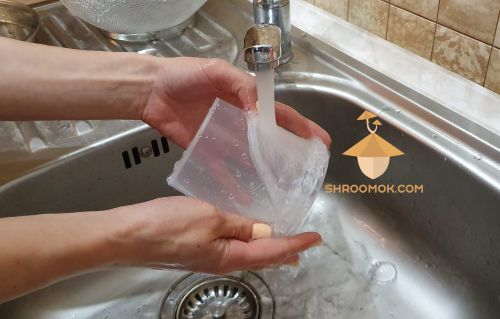
2. Make only one hole in each lid for the injection port and air filter. Diameter about 5-10 mm. Polypropylene lids can be burned through with a red-hot nail/awl or a screwdriver.
Or you can use hot gun.
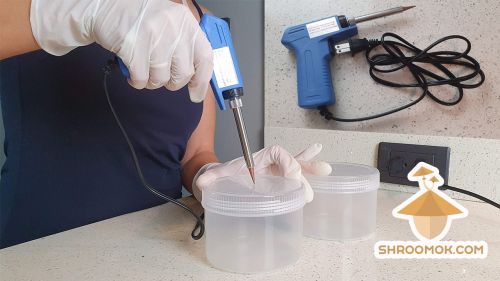
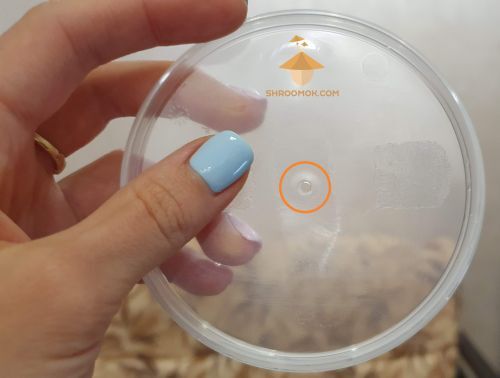
Tape inoculation port with a breathing bactericidal patch outside (omnipore or micropore tape). Try to stick the patch so that the breathing dots on the patch show you where the center of the inoculation port is. This will make inoculation more convenient.
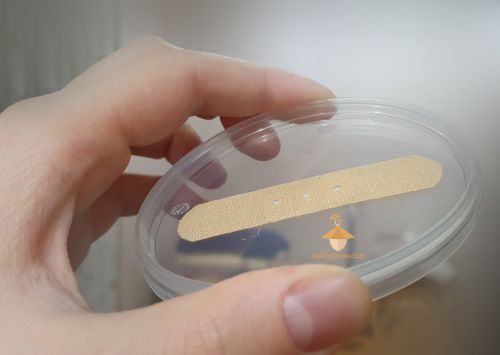
Shroomok's Choice on Amazon:
3M Micropore Tape 1530-1 (2 rolls) 1 x 10 yards - $4.40
Micropore Surgical Tape - 3m - 2" x 10 YD - 6 rolls - $9.76
🔴 For metal lids you can use a drill or punched with a nail/awl/screwdriver.
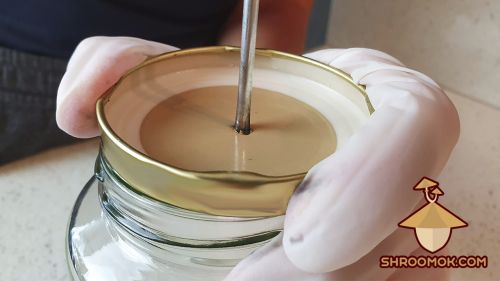
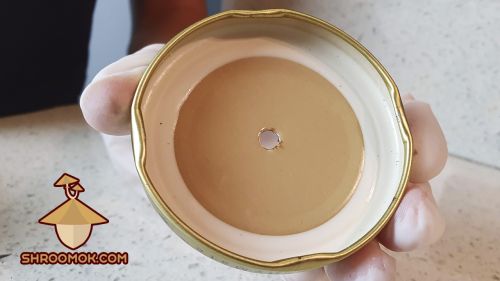
🔴 Important: if you make a hole in the metal lid, it is necessary to bend the metal pieces on the back side and seal this place with a breathing bactericidal patch both - inside and outside! It is necessary, because water drops with rust from the lid accumulated there and contamination can easy get in. For polypropylene jars only one breathing bactericidal patch (outside) is needed
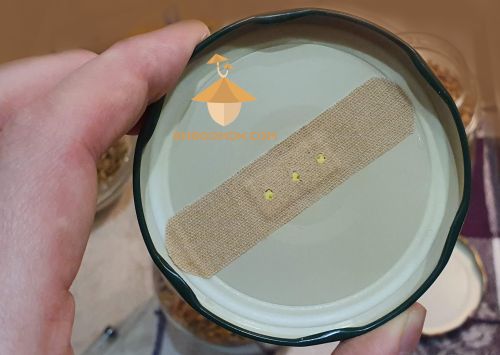
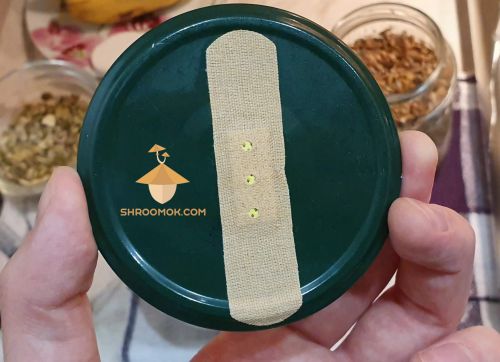
Jars for mushroom spawn are ready!
Move on the next stage — STEP 5. Grain substrate sterilization


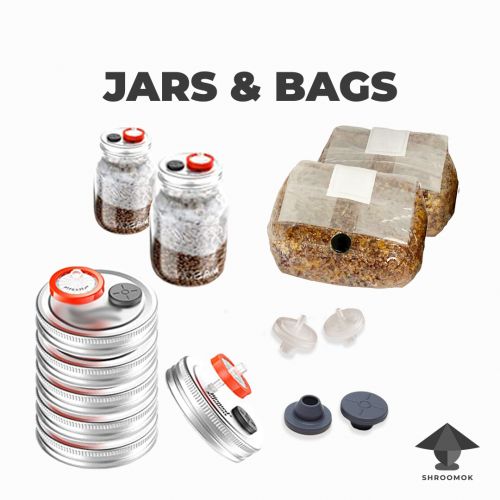
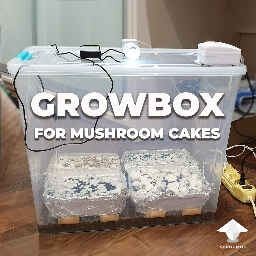
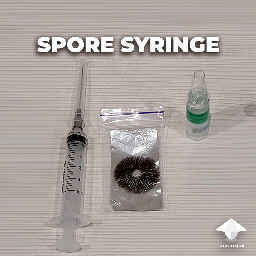

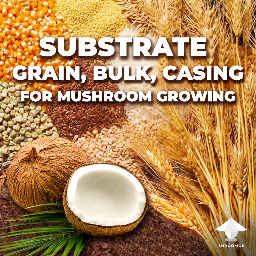
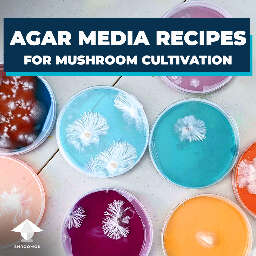
Comments
Why first there are photos and instructions about two holed lids but then you make only one hole?
@Dario, there are 2 options:
1) 2 holes –> one for injection port made of butyl rubber plug or silicone sealer (for inoculation), another – for a separate air filter (for gas exchange in the jar and also for steam flow during the sterilization process).
2) 1 hole –> 2-in-1 –> injection port + air filter made of bactericidal breathable tape.
We'll make inoculation through this one hole covered with tape on the Inoculation step here Inoculation without glove box and this breathable tape also will work as an air filter for gas exchange and for steam flow during sterilization.
You can make 2 separate holes if you want; no problem, it won't be a mistake.
Any option will work. The choice is yours!
Add comment